Church Street

We are now entering Church Street with guard railings on the High street pavement. The oak posts and rails, over 100 years old, were replaced in 2001 by The Steyning Society. The original posts served to tie up cattle on market days.
Gordon House, No. 2, was the Registrar’s Office where in 1891 the Irish politician Charles Stewart Parnell was married to Mrs. Kitty O’Shea. This liaison lost for him his struggle for Irish independence and finally caused his political downfall. A plaque about the marriage ceremony can be seen on the building.
The attractive group of old buildings on the right hand corner, Nos. l, 3 and 5, include part of another Wealden with its identifying features readily displayed. In recent years, two medieval shoes, one a child’s, were found in the roof; this was believed to be a custom to bring good luck to the house so they have been returned to their hiding place. A similar find was recently made in Causeway Cottage.
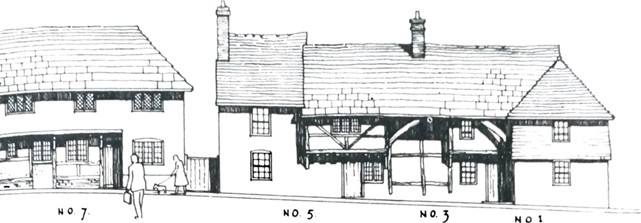
On the left side, the flint face of the end house No. 4, and the brick face of No. 6, conceal the timber framing of a single house No. 4 for many years was the Tuck Shop catering for the demands of the Grammar School pupils.
Continue along the right hand side of the street past No. 7, a disguised Wealden which used to be the cooper’s workshop and which supplied casks to the local breweries. Try to look inside and see all its original Wealden timbers. This building is known as Chatfields and is often open for exhibitions and other events.
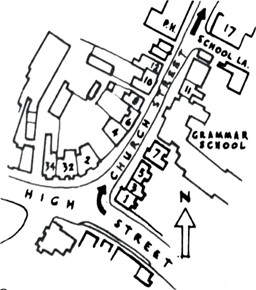
Since at least 1600 Nos. 10 and 12 opposite were operated as a Forge until before the last war. When one blacksmith named Hoad was deported for poaching pheasant on the Downs. his wife successfully continued to run the forge.
After his defeat at the battle of Worcester King Charles escaped and passed through Steyning and Bramber to reach Shoreham where he crossed to France. For disguise he travelled as the servant of his companion, Colonel Gunter, a squire from Racton in Sussex, and at the forge in Church Street, Col. Gunter is reputed to have had his horse shod.
The Grammar School, on your right, was endowed by William Holland, a Steyning man, in 1614 but had been used for ‘teaching little boys’ from 1584. It is a mid 15th. century continuous jetty type building and at some time its upper storey was protected by hanging tiles as shown in the drawing above. Then in 1985 these tiles were removed which restored the building to its original appearance with its fenestration and fine timber framed façade which is illustrated by the sketch on the title page. The entrance tower feature was added in the Jacobean period.
Although it is still called the Grammar School it has expanded rapidly and has been a large Comprehensive School since 1968 with buildings at the rear and a further vast complex on the Horsham Road.

Beyond the main entrance and now part of the school, the next building was yet another of Steyning’s public houses and until recently the old lettering of the Brewer’s Arms and ‘Drawn from the wood’ was still faintly visible on the stucco front of this building. Then comes Holland Cottage which was used for the Headmaster’s house. This too was once covered with hanging tiles but now presents an excellent example of a continuous jetty building of about 1500. Like so many framed buildings time and weather have taken toll of the lower storey timbers which have now been replaced with brick. The school building still has one or two vertical timbers showing between the later brickwork.

You are now at the end of School Lane which is the pedestrian access to Fletcher’s Croft car park. At the bottom of School Lane is the Steyning Centre where local community functions are held. The public house opposite the end of School Lane, the Norfolk Arms, is a 16th. century building despite its 19th. century exterior. This is very evident in the main bar. Originally a residence it also contains a superb Jacobean staircase which is well worth seeing. Sadly the Norfolk Arms is no longer operating, it now being a private residence.
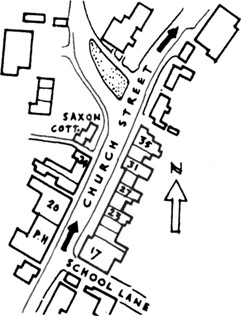
A very attractive row of cottages continues along the right hand side of Church Street. For some years these originally artisan dwellings were in a poor state of repair but recent changes of ownership have restored them to a new lease of life indicative of a social change to occupants seeking small period, perhaps quaint, houses or retirement homes. One such is No. 23, which has a plaque over its door, ‘This is Sir Harry Gough’s house 1771’ and this served to establish that gentleman’s status as an M.P. for Bramber when these houses were in Bramber and the boundary was in dispute.
Next door, Amberley Cottages, at one time a shop has been restored. Each cottage in the street has its own different character and each has details of interest which deserve individual study.
The Baker’s shop opposite on the left hand side of the street still has the old bread ovens at the rear.
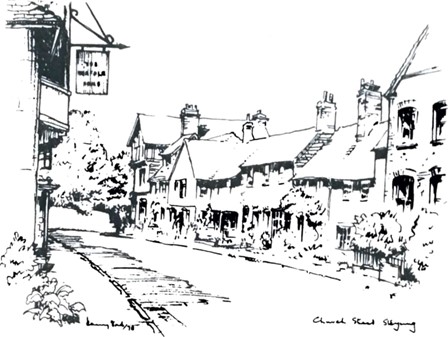
The next building of interest on the left side of the road is Vine Cottage, No. 24, but which has been largely rebuilt and extended although it retains the dormer window arrangement of the original house. There used to be a small lean-to shop at the north end selling boots and shoes and then it was a fish shop. Vine Cottage was once owned by the poet Victor Neuberg and here he published his works on his own Vine Press; copies are in the museum. Note the curious stone built into the front wall on the left, found in the foundations during rebuilding. On it is carved division grooves below a line of numerals and the initials R. W. It is a kind of tally but its purpose defeats us except that the initials were also on a door in the Norfolk Hotel which was once the residence of a Richard White about 1670.
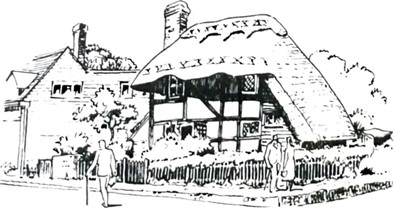
Next to Vine Cottage is Saxon Cottage, a delightful and much photographed thatched house with a ‘cat slide’, the long slope at the north end. Although a Saxon settlement existed hereabouts this building can be dated around 1550 and may have been the end bay of a large timber-framed ‘hall’ house set at right angles to the street. Now owned by the National Trust, it was at one time the temporary home for the Steyning Museum.
You will now find yourself at Chantry Green. Once you are ready press Next.